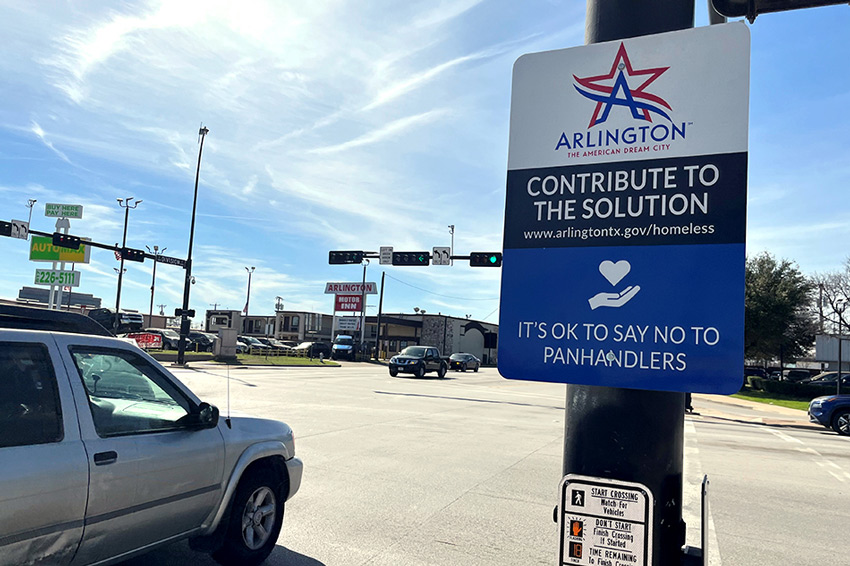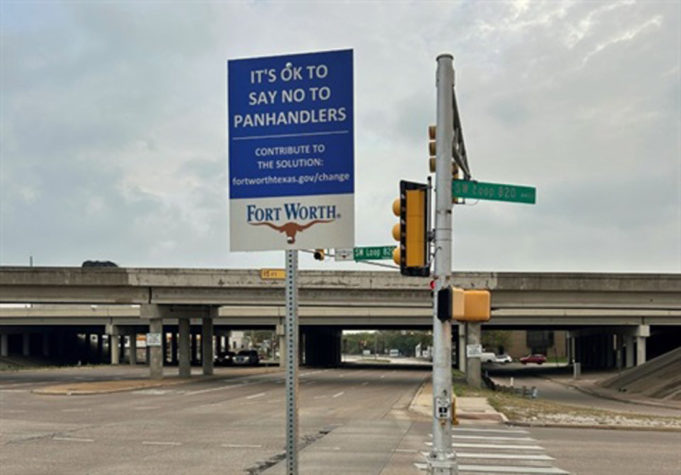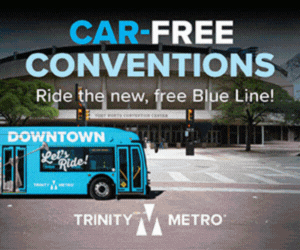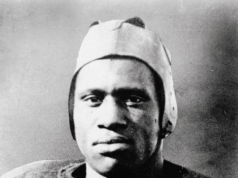Alex, a lean, curly haired, and tattooed 38-year-old, has a bead of sweat dripping off his sunburned nose as he stands in front of a traffic sign that says, “It’s OK to say no to panhandlers.” In his hand, he waves his own sign, this one soliciting donations from motorists stopping at the light at Bryant Irvin Road and the eastbound 820 service road.
Asked why he’s panhandling in front of a sign that discourages donations, Alex, who declined to give his last name, responded, “It’s not illegal.”
Indeed, there is no ordinance broadly prohibiting panhandling, although city laws forbid it in some cases. The sign Alex is standing in front of is one of 54 installed by the city since April as part of a new anti-panhandling initiative. The idea behind the project is to reduce the inducement to panhandle by making it less likely that people will give money.
Is it working? It is, according to Alex, who’s been working this corner for a year. “It’s effective,” he said decisively. “It’s cut the amount I get way back.”
Fort Worth’s sign program was initiated by the city council.
“The goal is to inform residents that it’s OK to say no to panhandlers and that there are better ways to give,” said District 4 Councilmember Charlie Lauersdorf, who was going to use district funds to install 10 signs at intersections identified in the MyFW app as having the most panhandling reports. He said the mayor proposed expanding it citywide.
“Right now,” he added, “we don’t know how the signs are performing since they’re still new, but after a year, we will compare reporting to see what, if any, impact they’ve had. What we do know is that the ‘no solicitation’ signs aren’t deterring the panhandlers, so we have to do something different, and that is deter those giving to panhandlers.”
The city has at least a couple of reasons to discourage panhandling, according to Bethany K. Warner, intergovernmental relations manager for the city manager. First, she said, the city would prefer donations go elsewhere. To that end, the signs include the URL FortWorthTexas.gov/change. Motorists who visit the site see a list of homeless support organizations. City policy is that giving to these groups provides a more sustainable solution than giving directly to an individual.
“Additionally,” she said, “the effort also seeks to help avoid unsafe roadside interactions that panhandling creates, which puts both the individual and drivers at risk.”
Standing in the roadway to solicit donations is already illegal in Fort Worth, as is panhandling near automated teller machines (ATMs), transit stations, and on private property. The same ordinance prohibits aggressive solicitation, such as threatening or intimidating behavior, continuing to solicit after a refusal, and blocking pedestrians or vehicles.
Fort Worth follows a number of cities in taking this approach. Arlington, for instance, installed similar signs in 2023 as part of a multi-pronged effort to reduce panhandling. Arlington Deputy City Manager Jennifer Wichmann said the city has considered or partially implemented public education efforts, traffic camera monitoring by police, and infrastructure redesign, such as changing street medians so they are difficult to stand on.
“There’s not a single solution to this,” Wichmann said. “It’s not something that’s going to be solved with one strategy.”
Still, the signs seem to work. Arlington’s initial pilot program in 2023 set up three sets of signs.
“We came back to council six months later and were able to tell them at those three locations, we’ve only had one panhandling call,” Wichmann said.
Based on that, they added seven locations this year.
Not everybody likes the idea. Elsewhere, signs have been defaced, covered up, and even torn down. Homeless advocates say the signs insult and demean panhandlers while highlighting government’s failure to provide other solutions, such as affordable housing.
In Arlington, Wichmann points out that the message applies to anyone soliciting donations, including members of sports teams and other non-homeless people. Evidence suggests, however, that homelessness drives most panhandling. For instance, a research study published in 2024 found about half of panhandlers in one European city were homeless, with many others marginally housed.
So far, Fort Worth’s Transportation & Public Works Department has installed signs at 14 of 27 intersections identified as panhandling hot spots. Once all signs are up, Warner said, they’ll monitor visits to the featured website, as well as panhandling complaints at these locations.
“Outcomes of this pilot effort will be assessed to determine next steps,” Warner said.
Meanwhile, Alex, who is homeless, works the corner at Bryant Irvin and 820 because it’s a good place to collect donations.
“Most places, you just get ignored,” he said. “Here, there’s a lot of traffic.”
Alex plans to keep it up, road sign or not. “I figure if it’s OK to say ‘no,’ it’s OK to say ‘yes.’

Courtesy the City of Arlington
”












